Contributory members are able to log private notes and comments about each site
Sites Anne T has logged. View this log as a table or view the most recent logs from everyone
Lindisfarne Priory
Date Added: 31st Oct 2015
Site Type: Museum
Country: England (Northumberland)
Visited: Yes on 18th Oct 2015. My rating: Condition 3 Ambience 4 Access 3
Lindisfarne Priory submitted by Thorgrim on 17th Nov 2004. Lindisfarne Priory has a fascinating museum of early carved stones and crosses. With a distant view of the Castle, Holy Island is a wonderful place to get in touch with the past.
(View photo, vote or add a comment)
Log Text: Anglo Saxon and Viking Stones on Lindisfarne, Northumberland. Sunday dawned dull and drizzly; looking up the weather forecast and the tide times for Lindisfarne strangely we were able to cross over (there and back) in the afternoon just when we wanted to.
In haste, I turned on my computer and printed off the AS Corpus sheets for Lindisfarne – there were over 50 stones listed, although some are now lost. We managed to see less than half of them.
I’ve never been to Lindisfarne at the weekend, so was amazed at the hoards of people wandering around. As parking is restricted on the island, we needed to park in the visitors car park and walk the rest of the way, but this was enjoyable in the sunshine. Fortunately we had our English Heritage membership cards to get free access to the priory and the museum. We only had to show our passes; we weren’t given tickets to count visitor numbers – just waved through.
We started off at the market place, only to find the old market cross had been replaced by a hideous concrete version; the original is now in the museum. In the museum, there were hoards and hoards of people all reading the descriptions of objects very carefully, and I got frustrated trying to photograph things without shadows and the strong museum lights in the way, so we went to the church to try and find a grave marker but couldn’t find it. We then went to the priory where we were the only people around for the first 20 minutes of so. Armed with the sheets, the guide was really interested in what we were trying to find, although we only found the cross base and what might have been the grave cover (AS Corpus Lindisfarne 48).
Going back to the museum half an hour before closing we were the only ones in besides the staff. I tried to get good photos of the marker stones but the lights were really strong and they were giving me a headache. I asked the lady at the desk if, as they were closing, I might be permitted to turn off the lights, but was given short shrift and told that someone else had managed. Then a staff member came and asked to turn off the light in the shop, and that was done, so I felt a bit put out!
Anyway, it was an enjoyable afternoon out, although its going to take me a while to process and label all the photographs.
Giants Grave, Penrith
Date Added: 22nd Oct 2015
Site Type: Ancient Cross
Country: England (Cumbria)
Visited: Yes on 10th Oct 2015. My rating: Condition 3 Ambience 4 Access 5

Giants Grave, Penrith submitted by nicoladidsbury on 12th Feb 2005. Giants Grave Viking Crosses and Hogback stones
The 'Giants Grave' is a collection of ancient grave stones comprising two 11' high stone crosses and four hog-back stones. An excavation of the 'Giants Grave' showed a skeleton underneath with a sword. The four hogback stones surrounding the grave are said to represent wild boar he killed in nearby Inglewood Forest.
(View photo, vote or add a comment)
Log Text: Norse Crosses and hogback tombstones (Giant's Grave), St Andrew's Church, Penrith: On our way to Kirkoswald, we stopped off in Penrith for a coffee and a cake. I remembered from some dim and distant memory that there were some Viking Hogbacks and Anglo Saxon crosses in Penrith but couldn’t remember which church they were in, and there was no mobile signal, so as we were opposite the church we walked into the churchyard anyway. And there was the small collection of 2 Norse crosses and 4 Viking hogback tombstones – very worn.
Inside the northern door of the church, to the right of the western-most ‘Giant’s Thumb’ cross there are some line drawings of the patterns on the crosses and the hogbacks. There is also a church guide, the back page of which has a short description of the Giant’s Grave.
Towards the north western end of the churchyard another cross stands on its own. Closer inspection highlights the inscription at its base, showing this is a reconstruction.
Looking at the Anglo Saxon Corpus just now (22nd October) we missed a couple of other stones – 1 built 4 metres up into the north wall of the tower (very worn) and another upside down near the south west corner of the church. As Penrith is a place we pass reasonably frequently, a repeat visit will definitely be in order!
St Oswald's Well (Kirkoswald)
Date Added: 22nd Oct 2015
Site Type: Holy Well or Sacred Spring
Country: England (Cumbria)
Visited: Yes on 10th Oct 2015. My rating: Condition 3 Ambience 4 Access 5
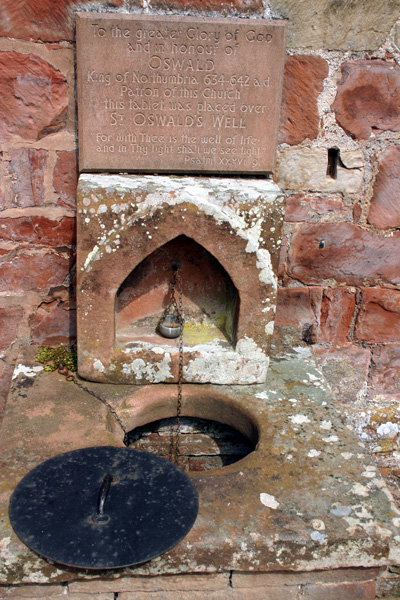
St Oswald's Well (Kirkoswald) submitted by ocifant on 25th Jun 2005. The well sits at the side of the church, against a hillside. The church bell tower is separate and sits at the top of the hill. There are steps and a door leading down to the well, but the door was locked. It is necessary to lower the drinking cup to obtain the water.
Apparently, the church boiler leaked some time ago, and the water was poluted with oil, and is no longer fit to drink, although it is still used for baptisms...
(View photo, vote or add a comment)
Log Text: Anglo Saxon stones and a holy well, Kirkoswald, Cumbria: This church is in a very pretty location, opposite "the college" and boasts not only an Anglo Saxon cross arm fragment and holy well but a separate bell tower on top of what looks like a motte. It is a little difficult to park, as there are narrow roads and high brick walls restricting vehicle access, and on the day we went lots of farmers towing trailers were travelling at relatively high speeds round the bends in the village. This church is in a very pretty location and boasts not only an Anglo Saxon cross arm fragment and well but a separate bell tower on top of what looks like a motte.
The approach to the church is pleasant, along the tree-lined Priest’s walk from the college opposite. The church itself sits at the foot of a steep hill and the wooden porch of 1523 is dark but welcoming. To the left of the porch on the exterior north wall sit a number of stone grave markers; the second from the right has ribs and is described in the church guide as being Saxon.
The church guide is really good, illustrating the development of the church from the 7th century (“when local people were discovered worshipping a God of the spring which issued out of the Bell Tower Hill”), through to the present day.
Inside the church the area immediately inside the door is cramped compared to the rest of the church. The sanctuary and east window, because it nestles at the foot of the hill, is comparatively dark. To your right, immediately to the right of the door is the font. The bowl is very old (described as being from the original Norman building) but the plinth appears modern. On the window ledge to the west, which the church guide says is Tudor, is mounted part of a Saxon cross arm, AS Corpus reference Kirkoswald (no number, as there is just one).
Apart from the well worn and partly destroyed stone effigy of Lady Dacre tucked between pews at the west end of the church, there is no much else to see inside. To the west end of the church outside is the enigmatic St. Oswald’s well. At first glance, it looks like an outside toilet, but on closer examination there is a metal cup on a long chain, a metal cap with handle and remnants of an old roof line over the well. Lifting off the metal lid, the water is free flowing and clear about 8 to 10 feet down. The cup reaches the water and I did draw a little and taste it – nothing exciting. I later read in the church guide that the water is still used for baptism, but drinking it isn’t recommended. At the southern side of the well are some steps with a red door which opens onto the water channel, presumably for clearing. I was surprised to find the water flows under the nave! The church guide says the source of the spring is unknown, but it must come from under Bell Tower Hill.
We missed a consecration cross in the retaining wall at the east end alongside an old sundial.
Walking round the southern end of the church a very narrow stile leads through the stone boundary wall of the churchyard and a path leads up into the Bell Tower Field. Climbing up this steep hill, the Bell Tower is particularly inaccessible as the slope up to the Bell Tower needs clambering up, then there is a sturdy fence with well padlocked gates. I was convinced this hill was an old motte.
Southwell Minster
Date Added: 29th Oct 2015
Site Type: Early Christian Sculptured Stone
Country: England (Nottinghamshire)
Visited: Yes on 20th Sep 2015. My rating: Condition 3 Ambience 4 Access 5
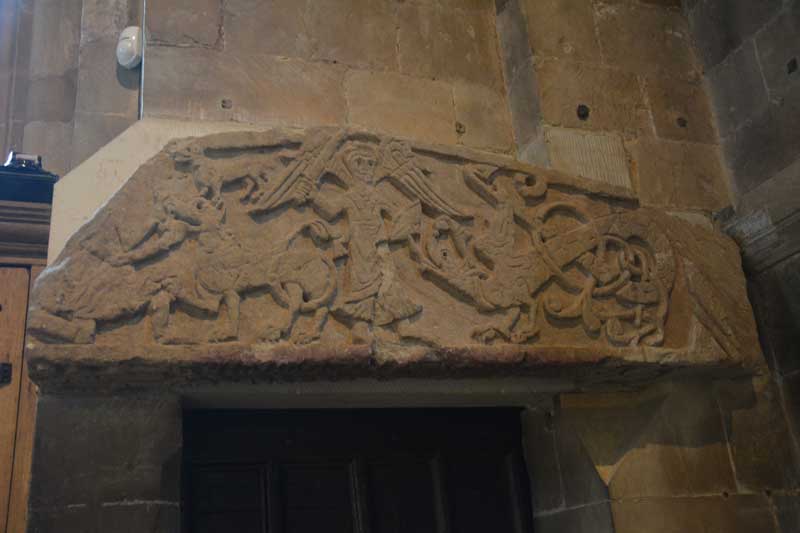
Southwell Minster submitted by Anne T on 26th Oct 2015. The front face of the tympanum, thought to come from the original Saxon building, which sits above the door on the west wall of the north transept. The carving shows St Michael warding off a dragon and is said to date from 1100.
(View photo, vote or add a comment)
Log Text: 10th/11th century tympanum, Southwell Minster, Nottinghamshire: On our way back from Grantham we took a short detour to Southwell. What a stunning little town, with a huge Minster. At the time of our visit there were two services running almost back to back, so we didn't get to see some of the early carved capitals. The tympanum on the western wall of the north transept more than made up for it, with its 11th century carving of St. Michael and the dragon facing us, then underneath (on the narrower face) was the remains of a 10th century Saxon grave cover. The light streamed through the window above, making it difficult to photograph well. I was astonished to find a photograph licence was £5! However, the greeter said as the verger was in the service, unless I was very obvious with my camera, we wouldn't be charged unless the verger spotted us! It was very late on Sunday afternoon at the time of our visit so the museum/café area wasn't open. It would be nice to go back at a time when services aren't on so we could see the quire, chancel and sanctuary and have a wander round at our leisure, but it's unlikely that we'll get back to Nottinghamshire any time soon.
St Mary the Virgin (Wirksworth)
Date Added: 22nd Oct 2015
Site Type: Early Christian Sculptured Stone
Country: England (Derbyshire)
Visited: Yes on 17th Sep 2015. My rating: Condition 3 Ambience 4 Access 5

St Mary the Virgin (Wirksworth) submitted by TimPrevett on 29th May 2006. The Wirksworth Stone - 8th or 9th Century carved coffin lid depicting Christ washing the feet of the disciples, the crucifixion, the body of the BVM being borne for burial, the presentation of Christ in the temple before Simeon, Christ's descent into Hell, Christ's Ascension, the Annunciation, and the Mission of the Church.
The picture was very difficult to take; direct sunlight coming through the window, spacial constraints, and the church busying ahead of a Choral Evensong; not that pleased ...
(View photo, vote or add a comment)
Log Text: Anglo Saxon Stones at St. Mary The Virgin, Wirksworth, Derbyshire: My husband's father had died unexpectedly last week and we were down sorting out the funeral and his house. It all got a bit too much, and I asked to 'run away' for the afternoon to do something different. Funny, we'd nearly bought a house here in the early 1980's, on the hills just outside the town, but never really explored this pretty little market town with its boutique shops.
We found the church behind the shops opposite the market square in a pretty oval shaped churchyard. It was much bigger than expected, feeling light and airy - more like a mini-cathedral - and with what Anglo Saxon treasures.
There were groups of stones built into the walls - by the north door, the walls of the south transept and the south western part of the nave.
The church offered a good guide book, but most useful was the 'treasure trail' for children along with the laminated guide sheet which showed the locations of the stones with a short description.
As I only had the camera on my phone we decided to go back with the camera proper, but time has run away with us and we never did get to go back. Thanks to modern technology the phone on my camera is better than the mini digital camera I usually carry with me.
St Mary's Churchyard Cross (Wirksworth)
Date Added: 24th Feb 2019
Site Type: Ancient Cross
Country: England (Derbyshire)
Visited: Yes on 17th Sep 2015. My rating: Condition 3 Ambience 4 Access 5

St Mary's Churchyard Cross (Wirksworth) submitted by Anne T on 22nd Oct 2015. This cross shaft and base sits in the north west part of the church yard. The church guide tells me that whilst the cross shaft dates from the 13th century, the cross base is pre-Norman.
(View photo, vote or add a comment)
Log Text: St Mary's Churchyard Cross, Wirksworth: I've split this page off as the cross has it's own HE scheduling record and Pastscape record, and got a little lost in with the other Anglo Saxon carved stones within the church itself.
Until we wandered around the churchyard, we didn't know this cross was here, so it was a really nice surprise to have seen it.
Ripon Cathedral
Date Added: 7th Sep 2015
Site Type: Ancient Cross
Country: England (Yorkshire (North))
Visited: Yes on 5th Sep 2015. My rating: Condition 3 Access 5
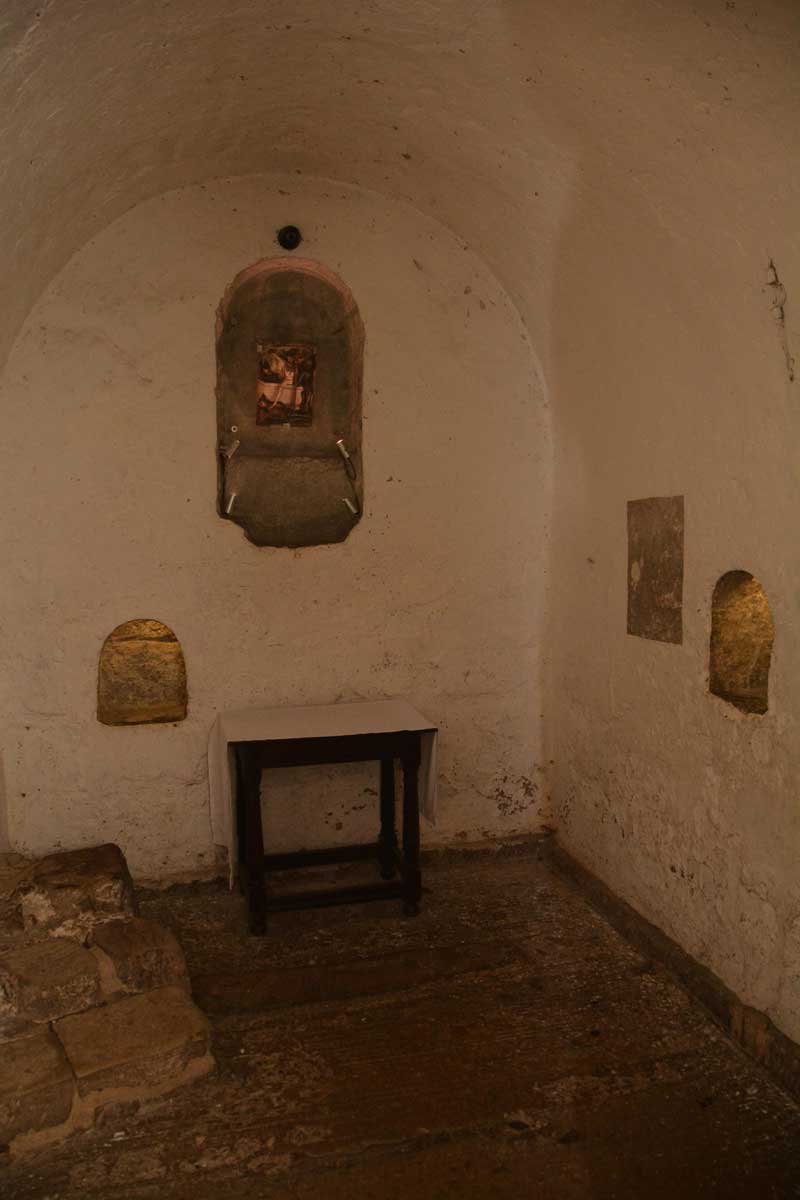
Ripon Cathedral submitted by Anne T on 3rd Aug 2015. This is the Anglo Saxon crypt at Ripon Cathedral, which is said to be part of St. Wilfrid's original 7th century church on this site. It has been white-washed since I visited 3 years ago. No sign of the Anglo Saxon cross fragments we were told might be down here, but very interesting never-the-less.
(View photo, vote or add a comment)
Log Text: Anglo Saxon Stones, Ripon Cathedral: Visit by arrangement with the Head Verger, 5th September 2015.
I'd made enquiries about the Anglo Saxon stones and received the following reply: "There is in fact little at Ripon by way of sculptured remains from the Anglo Saxon period. Clearly the Crypt itself is entirely Anglo Saxon, but there are no carvings here and some at least of the stones are Roman in origin. What remains otherwise are two stones built into the outer wall of the North Transept which are said to have come from Wilfrid’s 7th Century church. They have distinctive Celtic interlaced patterns. Also, in the Chapel of the Resurrection below the Chapter House there is a substantial drumstone which was one of two discovered in the 1990s under the tower. They are thought to be column bases from Wilfrid’s church. They are shaped with three stepped bands, but otherwise not decorated. One remains where it was found, the other now serves as an altar stone in the Chapel. (I wonder if these are the ‘imposts’ you have heard about?) The Chapel is not normally accessible, but it might be possible to arrange with a verger to see it.
The other early piece of stonework is the Sigurd Stone which is part of a stone cross which bears the image of the legend of Sigurd who was a Norse hero who sucked his thumb after a burning encounter with a dragon - though there are various interpretations of the story. The representation of this story on a Christian cross is of course remarkable, but this may not be of so much interest as it probably comes from a slightly later period. The stone fragment itself is currently in store."
In fact the Sigurd stone was largely obscured by staging, which hadn't been removed, so the verger on duty had to bring a torch to illuminate the three fragments, and I had to move fire extinguishers and clamber on top of staging to be able to see it at all. What a shame - this is a fantastic example of Anglo-Scandinavian carving. The verger also took me down to the Resurrection Chapel to see the large drumstone which now forms the altar; then we dived across into the north aisle to another small chapel to see another drumstone, worked into a font in the distant past but now topped with a modern circular mirror. We then went outside to see the stones in the external wall of the north transept (west end), then to the south nave where we'd spotted what looked like the remains of an ancient preaching cross (which I've also enquired about - yet to see a reply).
The cathedral was exceptionally busy, with the Great North Art Show being on, and the Northern Philharmonic Orchestra rehearsing for a concert that evening. Well worth going! Many thanks to the vergers for their time and patience.
First visit, 28th August 2015: Anglo Saxon Stones at Ripon Cathedral: I was intrigued by this page on the Portal, as I've been to several events here and not noticed any Anglo Saxon cross fragments , so when passing through decided to stop and have a look.
We were greeted by a guide and asked him if he knew of the whereabouts of any Anglo Saxon stones or sculptures and were told they were probably down in the Anglo Saxon Crypt. I also had to pay £3 in order to take photographs within the Cathedral.
The crypt has been white-washed since I last saw it (which is probably how it would have been in Anglo Saxon times) and this somewhat spoiled the ambience for me. There was a piece of wall left in its original condition, and you could see the remains of well worn scratches (possible runes and a small dedication cross?). I wasn't convinced this is what I was looking for.
Since coming home, I've researched what this stone(s) might be and found reference to a 'roman-looking' carved pillar and some imposts on the Corpus of Anglo Saxon Stone Sculpture web site. We certainly didn't find these, although we had a good scout round. I have since sent off an email to one of the senior admin team at the Cathedral, and will report back when I get a reply.
Robin Hood's Well ( Yorkshire)
Date Added: 8th Sep 2015
Site Type: Holy Well or Sacred Spring
Country: England (Yorkshire (North))
Visited: Yes on 5th Sep 2015. My rating: Condition 4 Ambience 3 Access 3
Robin Hood's Well ( Yorkshire) submitted by HOLYWELL on 16th May 2010. A Victorian fancy or pagan site? More likely the other as Robert James Culverwell in his
"The Enjoyment of Life; or Health, Recreation and Rational use of Time, 1850" notes:
Yet for awhile let gay fancy beguile us with merry visions of the past. On this glade, the Curtal Friar of Fountains encountered Robin Hood, whom at length he threw into the Skell and, afterwards, fought to his heart's content. Then whistled out so many of his good ban dogs; but Little John let his arrows fly among them ...
(View photo, vote or add a comment)
Log Text: Robin Hood's Well at Fountain's Abbey, North Yorkshire: After our visit to Ripon Cathedral to see the Anglo Saxon/Pre-Norman stones, we took our small grand-daughter over to Fountains Abbey to enjoy the sunshine in a beautiful location. Walking past the Abbey to Studley Royal Water Gardens, we retraced our steps on the opposite side of the River Skell to the Abbey ruins. I'd spotted this structure on the walk down and said "that looks like a well". When we went past it on the return leg of our walk, it was indeed a well, although dry. It wasn't until I got back and checked on the Portal that I found out it was "Robin Hood's Well."
The stones on the left hand side, as you face the well, look as if they are being undermined by the wear on the track that leads up past it to the woods, but comparing the photographs submitted in 2010, it hasn't changed much.
Peering inside the well, there is a stone channel on the left hand side at the top/back of the well which routes water (if there is any) into the basin at the bottom.
Copt Howe
Date Added: 25th Aug 2015
Site Type: Rock Art
Country: England (Cumbria)
Visited: Yes on 11th Aug 2015. My rating: Condition 3 Ambience 5 Access 4
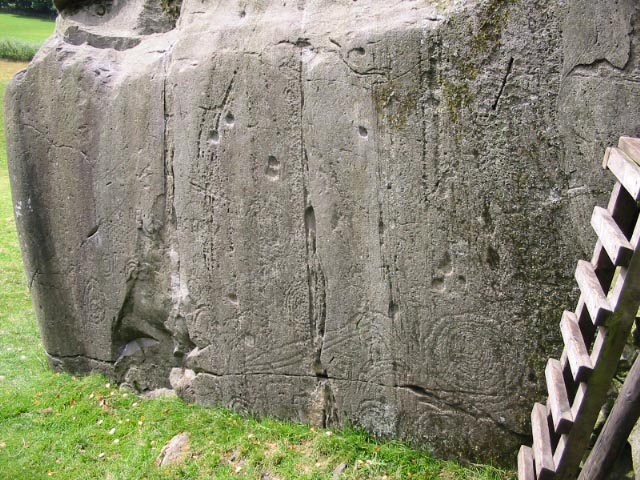
Copt Howe submitted by stu on 12th Oct 2003. NY3140 0582. Great carvings with one of the best views in the country.
(View photo, vote or add a comment)
Log Text: Copt Howe (The Langdale Boulders): When we drove past here on the way to Mickleden further down the Great Langdale valley, we spotted the signpost to Copt Howe but the road was so narrow and busy there was no room to stop. On the way back it was now after 6pm and the roads were quiet apart from one or two cars and cyclists. We parked behind another car in what seemed to be a narrow lay-by almost opposite the gate into the field containing these boulders.
If I thought the Mickleden walk scenery was beautiful (if stark with its tall peaks scree slopes) then this view down the Great Langdale valley was spectacular – green, lush and with rolling hills in the distance. What a location.
The rock art was on the largest boulder which was lowest in the field, sitting below the outcrop in which a tree now grows in the middle of. A very rickety stile climbed the stone wall to the other side, although when I touched this it came away from the wall, so I opted to walk down to the gate lower down in the field.
The early evening light was conducive in helping the motifs spring out of the rock. A few of the ‘cups’ were similar to the double cups on the Twelve Apostles in Dumfries, these being formed through natural erosion rather than pecking. I compared the designs I could see to the interpretation board but couldn’t quite reconcile the two.
In walking back up to the car I went round the left hand side of the tree (facing the road) and spotted a large single cup mark in the centre of the face.
Langdale Axe Factory
Date Added: 4th Jun 2017
Site Type: Ancient Mine, Quarry or other Industry
Country: England (Cumbria)
Visited: Yes on 11th Aug 2015. My rating: Condition 3 Ambience 5 Access 3
Langdale Axe Factory submitted by Thorgrim on 15th Nov 2003. The Langdale Pikes in Great Langdale.
(see article on Langdale Axes)
(View photo, vote or add a comment)
Log Text: Mickleden Way, finding pointers to the Pike O'Stickle Axe Factory: I was lucky enough to win a copy of Gabriel Blamires book in a Portal photographic competition. It arrived just in time for our trip over to the Lakes on 10th/11th August. We followed Chapter 4: The Mickleden Way, having parked at the National Trust pay and display car park next to the Old Dungeon Ghyll Hotel, and headed up behind the pub onto the stoney footpath into the hills.
This is a beautiful and easy walk with Mickleden Beck in the valley to the left hand side and Langdale Fell with Pike O’Stickle to our right. We were passed by a number of small climbing parties coming back the other way.
We found boulders 4.1 to 4.7. We had intended finding more but dusk stopped us in our tracks and had us retracing our steps back to the Hiker's Bar at the hotel The Pike O’Stickle Pentagon was perhaps the most dominant and impressive stone. To be found at NY 2738 0640 it stands out proudly on the hillside and is one of the more convincing markers/pointers. There has been some recent activity around both sides of the stone, with gullies being made to channel water off the hillside around it, hence it’s a bit tricky to get up to. From the banks of one of these gullies I picked up a lump of shiny black stone (now dried it is a dull green-grey with light brown inclusions) which was incredibly sharp. We later identified it as a piece of stone used for the axes, so it now sits proudly on my window ledge.
As our walk continued there were so many stones and stony outcrops that we started to wonder how Gabriel Blamires had chosen the pointers he did, as there were others which equally stood out in the landscape. He has obviously done an immense amount of research to check everything out. I did get excited at boulder 4.4 as bending down to retrieve the lens cap for my camera, I noticed that the top profile of the boulder seemed to echo the pattern of the peaks above.
Following the book to the letter, and thankful for our GPS, we got to boulder 4.7 before spotting what looked like an area of cairns.
There are many more boulders detailed in Gabriel's book, along with some stunning walks/ways and I really look forward to finding out more.
I do agree with rich32 that you would have needed ropes and parachutes to attempt to get up to the axe factory!
Fontburn a(vi)
Date Added: 1st Aug 2015
Site Type: Rock Art
Country: England (Northumberland)
Visited: Yes on 1st Aug 2015. My rating: Condition 3 Ambience 4 Access 3
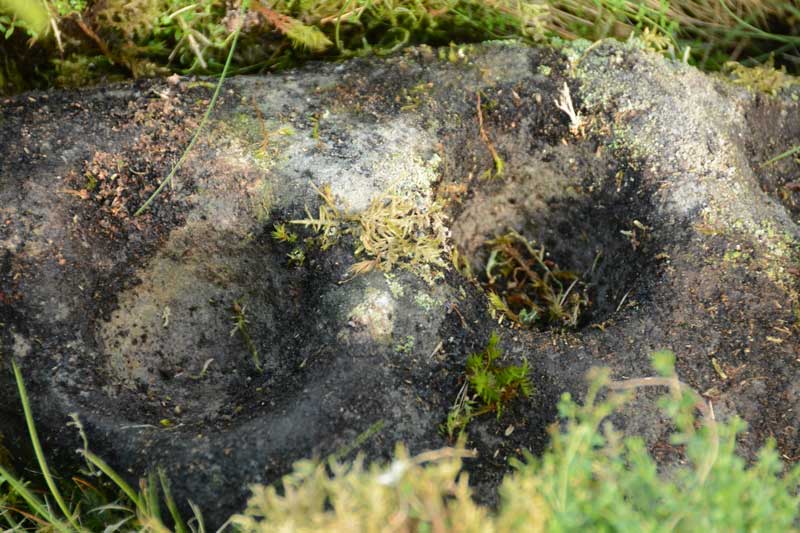
Fontburn a(vi) submitted by Anne T on 20th Jul 2015. Close up of the two deepest cups on the southern/top side of Fontburn a(vi). It was amazing how smooth and well definted these were, even after all these centuries.
(View photo, vote or add a comment)
Log Text: Fontburn a(vi), just off the National Trust Greenleighton Walk, Northumberland: See visit report for Hollinghill Enclosure.
All Saints (Ingleby Arncliffe)
Date Added: 29th Apr 2017
Site Type: Ancient Cross
Country: England (Yorkshire (North))
Visited: Yes on 28th Jul 2015. My rating: Condition 3 Ambience 3 Access 5

All Saints (Ingleby Arncliffe) submitted by Anne T on 4th Aug 2015. This is the cross which can be found leaning against the north wall of the porch of All Saints, Ingleby Arncliffe. The porch is at the base of the tower.
(View photo, vote or add a comment)
Log Text: Ancient Cross, All Saints Ingleby Arncliffe, North Yorkshire: All Saints at Ingleby Arncliffe is very close to the A19 so we thought we’d stop off on the way back home, but finding this church was quite interesting – we had three unsuccessful attempts, driving down different roads from the centre of the village of Ingleby Cross. In the end, I got the GPS out and found the church straight away. The church is located about a quarter of a mile to the south-east of Ingleby Cross village, having to cross the A172 to reach it. From the cross roads the church is approx. 200 yards to the right hand side with a small parking area by the main gate to the churchyard.
The church many now be really distant from the village, but is right next to the manor house which dominates the view of the churchyard. The church itself was (not surprisingly for the early evening) locked, but we could gain access to the porch which is in the lower part of the tower. There was a cross (very similar to the one at Wath) leaning up against the north wall. We walked right around the building twice but could see no other crosses/old stone fragments built into the fabric of the building. There are supposed to be two more stones built into the tower along with another in the vestry according to the Yorkshire Moors Gazetter. The entry for Ingleby Arncliffe on the British History site says “A hog-back stone found about fifty years ago in a hedge bank and a later coped gravestone are now in the Cathedral Library.”
We peered through the windows of the church, and it appears to be all original box pews with a three-tier pulpit. I have sent an email to the vicar, through the ‘A Church Near You’ web site, asking if it’s possible to pick up a key next week to get inside the church and also see if we can find the stones in the tower.
All Saints (Northallerton)
Date Added: 4th Aug 2015
Site Type: Ancient Cross
Country: England (Yorkshire (North))
Visited: Yes on 28th Jul 2015. My rating: Condition 3 Ambience 4 Access 5

All Saints (Northallerton) submitted by Anne T on 4th Aug 2015. This wonderful cross head sits on the step at the north western corner of the quire.
(View photo, vote or add a comment)
Log Text: Anglo Danish cross fragments, All Saints Church, Northallerton, North Yorkshire: I found the exterior of All Saints in Northallerton, which sits at the northern end of the High Street on the A167, very forbidding with its blackened stones. However, the inside was nice enough, although very Victorian, and we were made very welcome by a parishioner who had popped in to collect the church magazine. I had to chuckle as the “A Brief Guide to All Saints Parish Church” which says the oldest thing in the church is the Norman grave cover (to be found at the northern eastern corner of the nave). They have ignored the Anglo Saxon (or they correctly call it in this part of the world, Anglo Danish) stones on the window ledges.
The guide book says that there was supposed to be a church of stone built here in the early 7th century by St. Paulinus. “Fragments of stone crosses, possibly of this period, still exist, some built into the walls at various places, while a very fine cross head and separate shaft are on permanent loan to Bede’s World ..... although there is no visual evidence to suggest a significant stone building before the 11th century.” For the picture of the Northallerton Cross at Bede’s world, follow the link http://www.megalithic.co.uk/modules.php?op=modload&name=a312&file=index&do=showpic&pid=133724.
All the crosses, apart from one, which is at the south eastern corner of the choir, sit on window-ledges, most along the north wall and north transept, but some in the small kitchen area at the west end of the north transept. Most remarkable is the fragment with what looks like a sheep.
I’ve had difficulty in finding out more about these stone fragments, although the Corpus of Anglo Saxon Stone Sculpture web site says the North Yorkshire collection will be on-line soon.
Funnily enough, the church guide prides itself on the Robert Mouseman mice on the wooden furniture, and there is a special “Mouse Guide To All Saints Parish Church Northallerton.”
All Saints (Kirby Hill)
Date Added: 4th Aug 2015
Site Type: Ancient Cross
Country: England (Yorkshire (North))
Visited: Yes on 28th Jul 2015. My rating: Condition 3 Ambience 5 Access 5

All Saints (Kirby Hill) submitted by Anne T on 4th Aug 2015. These are the Anglo Saxon cross shafts, cross head and an early grave marker displayed on the north wall of the tower.
(View photo, vote or add a comment)
Log Text: Anglo Saxon Crosses, Kirby on the Moor (Kirby Hill), North Yorkshire: All Saints sits on a green just outside the village of Kirby on the Moor, between Church Lane and Millings Lane. There was a notice near the entrance gate saying the church was open on Sundays between 2pm and 4.30pm and ‘all welcome’. However there was a car parked by the church gate and we could hear someone playing the organ. Entering cautiously, I asked if it was OK if we could look around, and the gentleman nodded. He was clearly practicing a piece over and over and I felt we were distracting him somewhat. He had lit the area around the organ, but no lights were on in the church, so it became a bit difficult see the crosses into the interior church walls as I kept having to fire the flash to see. We thanked him and escaped.
The majority of the crosses are displayed in the north wall of the tower, next to the font, so it’s a bit difficult to get great photos as the space is so small. There was a leaflet about the Anglo Saxon stone sculptures that was really helpful.
I’ve just found their web site, All Saints Kirby Hill, which is great. The church is grade 1 listed, the nave being part late Saxon/early Norman, built with large irregular stones including carved slabs and cross shafts of Saxon origin. The web site tells me that the site is one mile north of Boroughbridge, the church is also known as Kirby Hill, and is at the highest point of the village, in line with Aldborough (the Roman civil capital Isurium Brigantum) and other probable sites of the Roman crossings of the River Ure.and is probably on the site of much earlier shrines dating back to Roman or even Celtic times.
St Mary (Thornton Watlass)
Date Added: 1st Aug 2015
Site Type: Ancient Cross
Country: England (Yorkshire (North))
Visited: Yes on 23rd Jul 2015. My rating: Condition 3 Ambience 3 Access 5

St Mary (Thornton Watlass) submitted by Anne T on 1st Aug 2015. This is the second cross head which is built into the east wall of the porch. It dates from the first half of the tenth century.
(View photo, vote or add a comment)
Log Text: Anglo Saxon Cross Heads, St Mary The Virgin (Thornton Watlass), North Yorkshire: St Mary The Virgin is 3 miles from Bedale and 11 miles from Ripon. It is grade II listed (English Heritage Building ID: 333615), dating largely from the 15th century.
There are two Anglo Saxon cross heads on display in the porch, one on the east wall and one on the west. The church was firmly locked at the time of our visit although the door to the porch was left open. We parked on the small triangle of land at the cross-roads opposite. It was tricky to cross the road as the church lies in the crook of a sharp bend and traffic cannot be seen until the last minute, so cross quickly!
According to the Corpus of Anglo Saxon Stone Sculpture by James Lang (Google books) "The cross head built into the interior east wall of the porch was first noted in 1908 by E. Bogg as being in its present position. Its height is 44.2 cms by 32.8 cms wide and 17 cms deep. Made of fine to medium-grained millstone grit, the right arm of the cross is lost and only one face is visible, and is part of a wheel-head cross with wedge-shaped arms and a ring recessed from the face. Date: first half of 10th century; The cross head in the west wall is 29.5 cms high, 48 cms wide (no depth recorded as it is built into the wall). The upper limb of the cross is lost; only one face is visible. Part of a plate-headed wheel cross, the rim raised and recessed from the face. A plain edge moulding follows the perimeter of the cross ... the lower limb of the cross has a curved incision which creates the impression at the sides of heavily stylised legs for a Crucifixion; conversely it could be the arris of a plain panel. The lateral arms are filled by hands with a wrist band and three huge fingers. In the centre of the cross is a large boss. Date: first half of the tenth century."
I admit to not being able to see the crucifixion scene described by James Lang in the Corpus of Anglo-Saxon Stone Sculpture (Google books) until I rotated my photograph by 90 degrees!
St Mary (Wath)
Date Added: 1st Aug 2015
Site Type: Ancient Cross
Country: England (Yorkshire (North))
Visited: Yes on 23rd Jul 2015. My rating: Condition 3 Ambience 3 Access 5
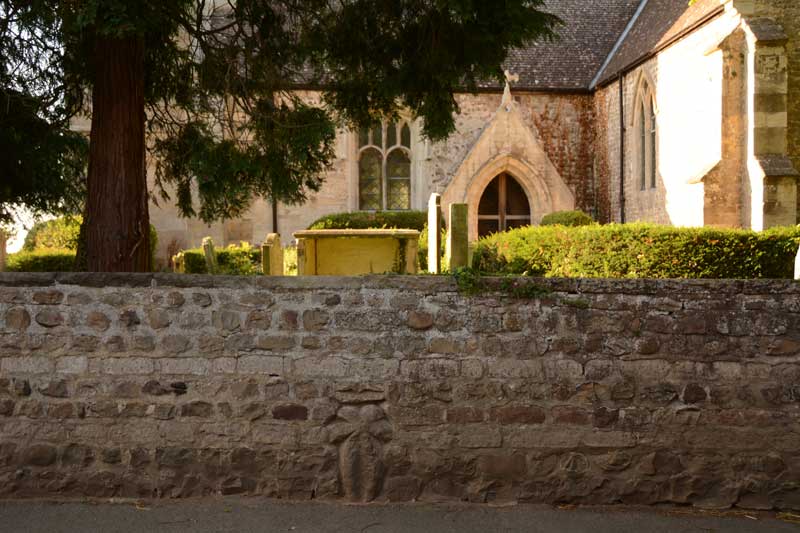
St Mary (Wath) submitted by Anne T on 1st Aug 2015. As the church was locked at the time of our visit, this is the only cross we could find, in the exterior church wall, almost in line with the porch in the south wall of the church.
(View photo, vote or add a comment)
Log Text: Anglo Saxon Cross, St. Mary's Church, Wath: Situated on a bend in Main Street, Wath, this church is in a pretty little village. We parked outside the main gate of the church (there is just room for one car to sit here, as someone else’s gates are immediately adjacent). We eventually found the cross in the exterior of the church wall, in line with the porch in the south wall of the church. There are only narrow pavements running alongside; the size of the lorries that rumble through making taking photographs of this cross precarious, to say the least. Andrew watched both sides of the bend to ensure I wasn’t going to get run over when I took a photograph from the middle of the road.
I found a document by Harrogate Council which told me a little more about the church and village: Wath is the Old Norse term meaning ‘ford’ and is mentioned in the Domesday Book of 1086. There are parts of the church that are very old indeed, and the above booklet mentions “The only built fabric from around this time are the remains of Saxon sculptures in the organ chamber of the present St Mary’s Church and the stone cross embedded into the church boundary wall.” The church was locked at the time of our visit (which was after 6pm) so we couldn’t get into see these. There was an old sundial in the churchyard, just south of the porch. The booklet goes onto say that Wath was essentially the estate village to Norton Conyers, and “St Mary’s Church is the oldest building in the village. It dates primarily from the thirteenth century with additions and enlargement in the fifteenth century and a tower of 1812. It might have originally been a manorial chapel which was rebuilt as a parish church in the twelfth or thirteenth century. The next oldest building in the village is the Rectory, which dates from the sixteenth century and was probably built on the site of its predecessor.”
St Mary (Masham)
Date Added: 1st Aug 2015
Site Type: Ancient Cross
Country: England (Yorkshire (North))
Visited: Yes on 23rd Jul 2015. My rating: Condition 3 Ambience 4 Access 5
St Mary (Masham) submitted by rogerkread on 22nd Oct 2013. The splendid Masham cross pillar, in the rain (as usual when I'm taking photos for the Megalithic Portal!).
(View photo, vote or add a comment)
Log Text: Four Anglo Saxon Crosses in the church of St. Mary The Virgin, Masham, North Yorkshire: After seeing the Anglo-Danish and Anglo-Saxon crosses at both East Hauxley and Wath, we went into Masham to get some lunch. Having visited here twice before, we’d never ventured into the church here (either having been with some disinterested visitors or at the end of an already long day), although I vaguely knew there were some Anglo Saxon crosses here.
The base of the large sandstone cross shaft cannot be missed and stands in the churchyard near the porch and dates from the early ninth century. The church guide states that "recent research has linked it stylistically with a broken cross shaft of similar date now at Cundall and Aldborough.” The panels on this cross shaft are very worn, and the top is capped with an ugly lead cap, presumably to stop further weathering. The text in the church and the church guide book told us that the incomplete top panels almost certainly represent Christ and his Apostles; the second and third panels contain scenes from the Old Testament.
Inside the church are three other cross shafts, two hidden conveniently in an alcove in the wall in the south aisle, behind the votive candle table, which we moved to take photographs, and carefully placed back. Exploring some medieval grave markers next to these, we came across another fragment of cross shaft with a notice next to it telling us it was from the late 8th/early 9th century. This fragment was very plain with only edge moulding visible on one edge.
St Wilfrid's Holy Well
Date Added: 1st Aug 2015
Site Type: Holy Well or Sacred Spring
Country: England (Yorkshire (North))
Visited: Yes on 23rd Jul 2015. My rating: Condition 3 Ambience 3 Access 5

St Wilfrid's Holy Well submitted by Sunny100 on 8th Jun 2010. St Wilfrid's Holy Well at Ripon, N.Yorks. SE.309710.
(View photo, vote or add a comment)
Log Text: St. Wilfrid's Holy Well, Skellgate Road, Ripon: Armed with only a 6 digit grid reference and a GPS device that was rapidly running out of battery, this well took some finding, but in the end we did. St. Wilfrid’s Well is located at the north side of the B6265, some 700 metres west of the city centre, where Skellbank Road becomes Mallorie Park Drive. A few yards east of the well are some steps leading up to Ripon Spa Gardens. The 8 digit grid reference is SE 3085 7102.
The well is located within a stone wall, almost overhung by bushes from the bank above. At the time of our visit there was no water trickling into the well at all. Someone seems to care for it, for there was no litter in or around it.
St Wilfrid is the patron saint of Ripon (the crypt at Ripon Cathedral is purported to be part of his early church, although I’ve yet to verify this). The St Wilfrid’s Day parade takes place on the Saturday before the first Monday of August each year (this year it happens to be 1st August (2015)) in which an actor takes the part of St. Wilfrid. The procession now centres around the Market Square, starting at Studley Road, then Westgate, Market Place West, North Street, North Road, Magdalens Road, Stonebridgegate, Allhallowgate, Market Place East, Kirkgate, Bedern Bank, Bondgate, Southgate, Barefoot Street, Harrogate Road, High Skellgate, Westgate, Blossomgate, Marshall Way, North Street, Market Place East, Kirkgate, ending at Ripon Cathedral.
Worth stopping to look if you are passing by this well.
Hollinghill Enclosure
Date Added: 1st Aug 2015
Site Type: Misc. Earthwork
Country: England (Northumberland)
Visited: Yes on 15th Jul 2015. My rating: Condition 2 Ambience 3 Access 3
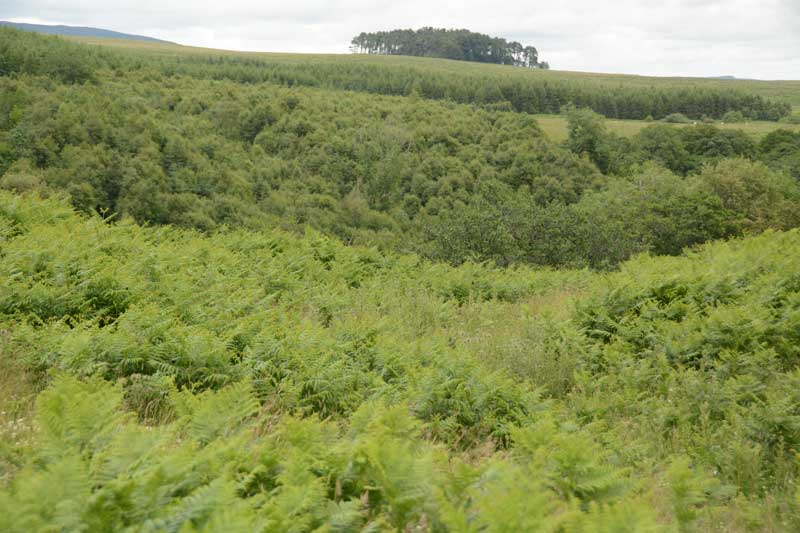
Hollinghill Enclosure submitted by Anne T on 18th Jul 2015. Believe it or not, there is a ditch approximately 1 metre deep in the lower right hand quadrant of the photograph, on the gentle slope leading down to Fallowlees Burn. Across the burn to the north lies the Fontburn Four Poster Stone Circle. This photograph is taken from the Greenleighton Walk footpath, where it cuts the eastern bank of the enclosure half way along its length.
(View photo, vote or add a comment)
Log Text: Hollinghill Enclosure, near Fontburn Reservoir, Northumberland: Before setting off on this walk, we'd identified a number of sites (2 enclosures and several rock art boulders) close to tracks/marked pathways on the Ordnance Survey map. Parking at the car park to the east of Fontburn Reservoir (near the fishing hut and as far south as we could get), we followed the Waterside Walk along the south side of the reservoir. This was slow as we got caught up with a large walking group who hogged the boardwalks, but we finally managed to overtake them. At the sign for the Nature Reserve, we clambered up the small slope onto the track across the access land leading to the west of the reservoir. I confess to finding walking across this access land challenging due to the heavily tussocked grass, no clear pathways, the number of drainage channels, small streams and boggy areas to cross (but seasoned walkers will have no difficulty!). Passing the large cup marked boulder (Fontburn B) on route, we made our way onto the ridge running east-west south of Fallowlees Burn, and onto the National Trust Greenleighton walk with its grassy, mown trackways clearly visible.
It is relatively easy to spot this settlement as the path cuts right through it and there is a lone, low hawthorn tree at its western side. From here, you can see across the Burn to Fontburn Four Poster (it looks, from a distance) as if someone has cut down the hawthorn trees near the stones making up this little circle).
Stopping for a drink and to take photos, we carried on westwards until we got to West Shank enclosure, which is much more visible in the landscape in the then took the modern farm track down the slope to Fallowlees Burn, then across the wooden bridge. On the north side of the bridge two sets of quad bike tracks lead off to the left and right. To the right, the land slopes upwards. Fontburn a(i), a(ii) and a(iii) sit on this land, no more than 100 metres from the footpath, but at this time of year a(i) and a(ii) are hidden by tall bracken. Fontburn a(iii) gleams at you from across the valley.
Having taken these three boulders in, we retraced our steps to the footbridge and took the quad bike tracks to the left hand side, picking our way over two small streams which join Fallowlees Burn close to the the footbridge. From here, it is easy walking up the slope, about 200 yards to Fontburn a(vi), a(vii) and a(viii) and Fallowlees Settlement.
All in all, this 4 and a half mile walk took us 6 hours because of the heavy terrain and exploring the archaeology, but well worth it.
West Shank Enclosure
Date Added: 1st Aug 2015
Site Type: Misc. Earthwork
Country: England (Northumberland)
Visited: Yes on 15th Jul 2015. My rating: Condition 2 Ambience 3 Access 3

West Shank Enclosure submitted by Anne T on 18th Jul 2015. Standing in the boundary ditch where the footpath cuts the enclosure looking east back towards Hollinghill Enclosure. The banks rise gently up on either side. The vegetation here is short grass, cropped by sheep, so are more obvious than the banks and ditches of the neighbouring Hollinghill Enclosure.
(View photo, vote or add a comment)
Log Text: West Shank Enclosure, near Fontburn Reservoir, Northumberland: See visit report for Hollinghill Enclosure.
